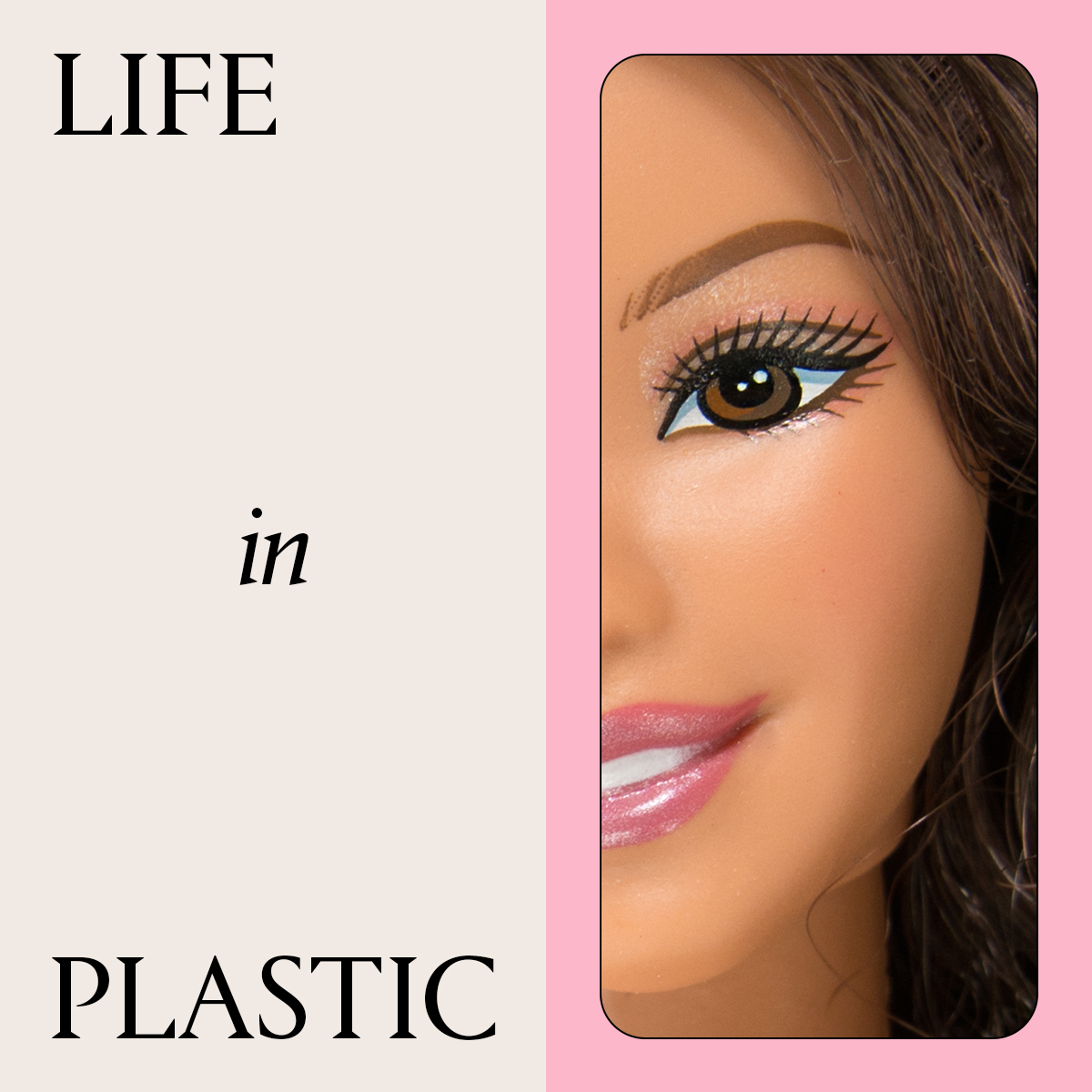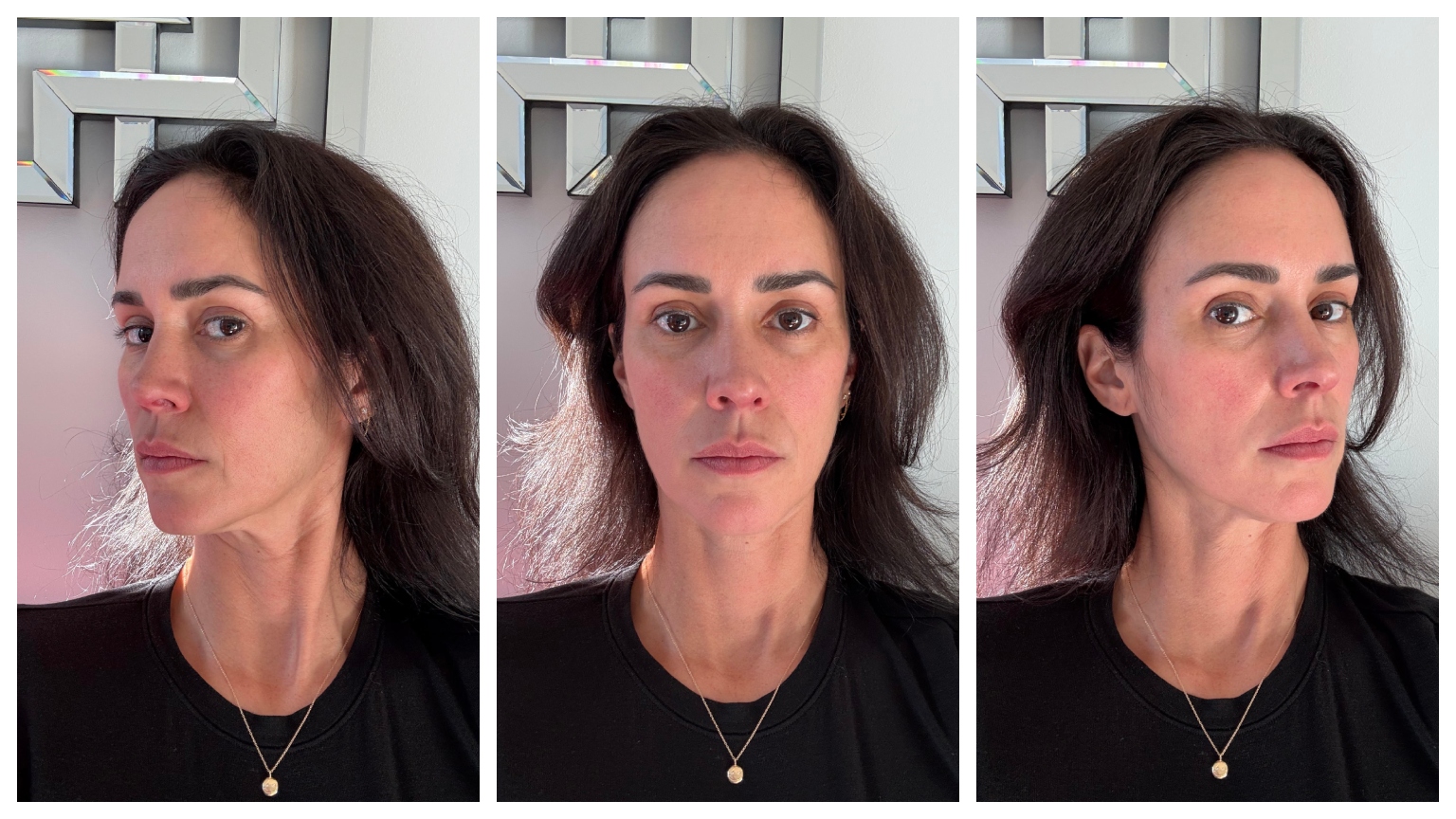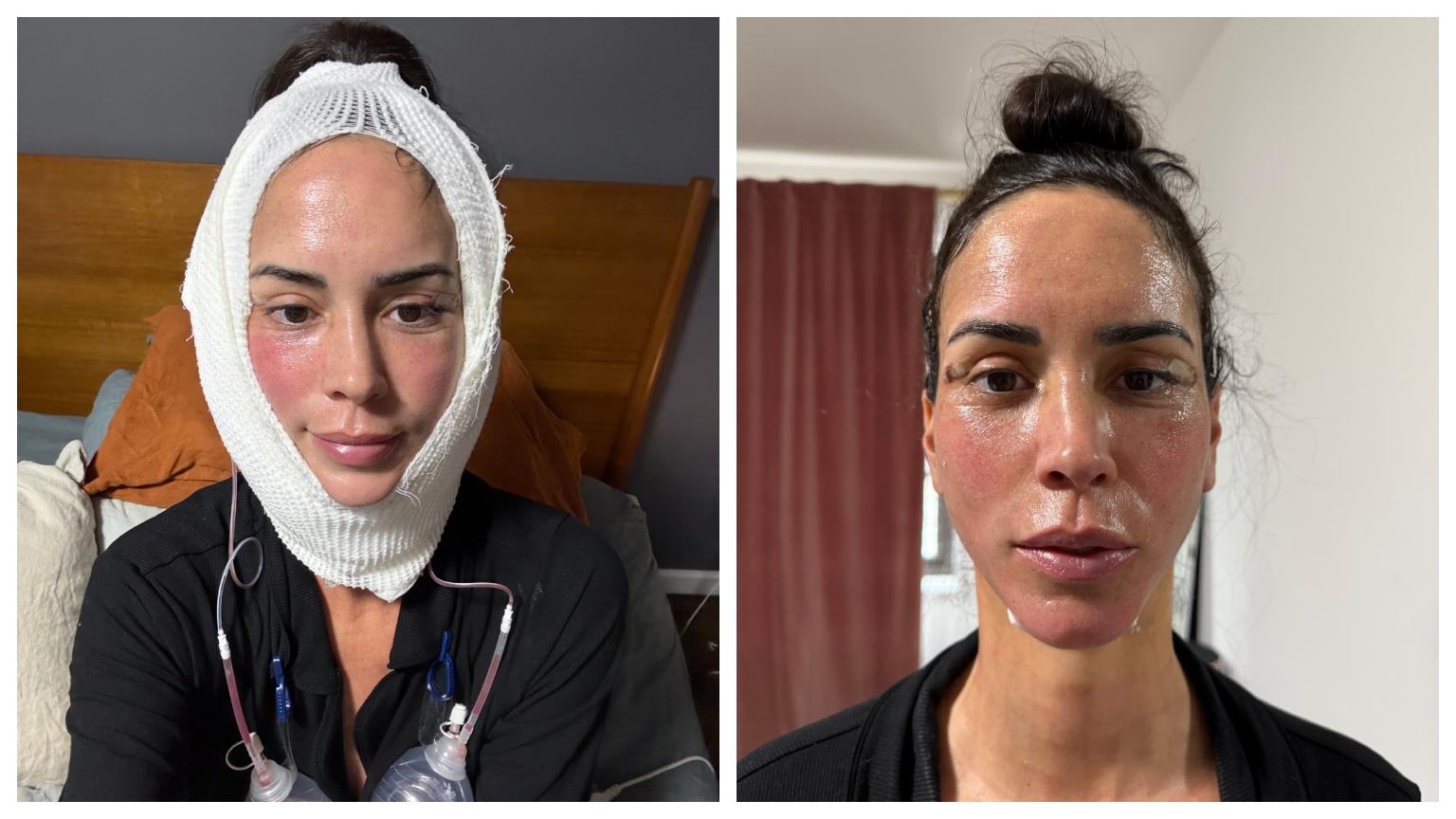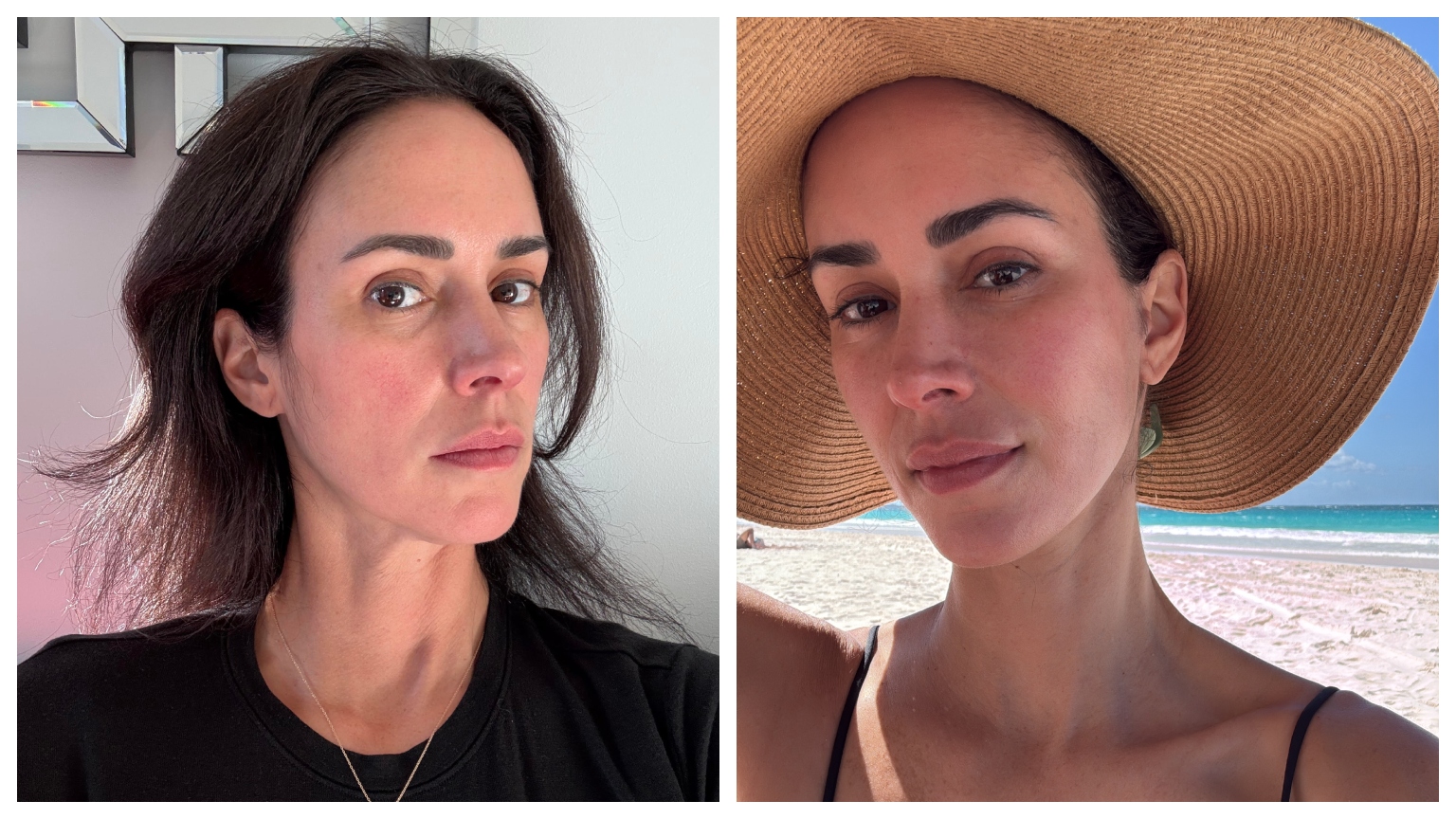
Nothing gets us more excited than talking about a not-so-little tweakment or a nip-tuck procedure. In the spirit of transparency, Marie Claire’s aesthetics column, Life in Plastic, delivers a first-hand peak into what goes on behind the doctor’s door.
Julia R is a 43-year-old woman living in NYC, who underwent a face and neck lift in December 2024. This is her story, as told to Marie Claire, edited for length and clarity.
It’s so important for me to have great skin quality. I work in a plastic surgeon’s office, Steven Levine, M.D. in Manhattan, and I’ve had Botox, radiofrequency microneedling, fractional lasers, CO2 lasers—I’ve done pretty much everything except threads and Ultherapy. My skin at 43 is the best I’ve ever had it in my life. A few years back, I noticed there was some fullness under my chin, so I tried Kybella and it did a pretty good job of removing that fullness. But then I went on Mounjaro [a GLP-1 medication] and I lost 60 pounds. So now, even though my overall skin health has improved, the skin laxity is really pronounced. When I look in the mirror I feel like no matter how healthy and even-toned my skin is, it’s still just kind of hanging there. There was no picture I would take where I could hide that little gobble under my neck, despite doing all these non-invasive procedures.
This is not the first time I’ve had plastic surgery—my upper eyes have bothered me forever, so I had an upper blepharoplasty four years ago, right before I turned 40, and I had a rhinoplasty last year. But when you lose that much weight, it changes the structure of your face. My eyelids were even saggier than they were before the bleph!
A lot of people think a face and neck lift is only for older patients, but I think my generation is approaching plastic surgery all wrong. A lot of people still have the impression that the pulled back look is what a facelift looks like, so they’re scared. But, as someone who works in medicine, I’ve seen that you have a better outcome if you undergo the procedure before the deep wrinkles set in, which happens in your mid- to late forties. We’ve seen a lot more 40-year-olds come into the office where I work. I think that’s because more people don’t want to wait until they start looking older to have these procedures done.
Doing this now, it’s pulling back the skin when it’s young and supple, rather than when those wrinkles have set in and you might still see them even after the procedure has been done. “The primary difference between patients in their 40s and 60s is the extent of aging and amounts of elasticity in the skin,” says Dr. Levine. “Because the younger patient has fewer signs of aging and usually better skin elasticity, they can expect a result that corrects nearly all signs of aging. Even when tissue is perfectly repositioned in older patients, because the quality of skin is diminished, the results can never be what they are in younger patients.” If what bothers you are your neck and your jowls, stop wasting your money with all those non-invasive procedures—it’s time for a facelift.

My Facelift Consultation
Once I decided I was ready for a facelift, the first step was a consultation appointment with my surgeon, Dr. Levine. There, he looked at my face, decided what procedures made the most sense, made sure I was a candidate for them, that I would get a benefit from surgery, and talked about timing. I decided to do my face and neck lift in the winter because why would I want to waste my summer recovering? Also, if it’s winter, I can do a better job of hiding the signs of recovery with scarves and hats. Plus, I knew it would be quieter because everyone leaves the city for the holidays. So we scheduled my procedure for December 19—the last surgery of 2024 for the office. I was off work for two and a half weeks and then was back to the office. I don’t know if I’d really recommend that for everyone, but I didn’t really have a choice.
My Facelift Pre-Op
We did the pre-operative appointment the week of my surgery, which is where the doctor really nails down what is being done, how it’s being done, and if there is anything additional you want to add. I call it the Sephora checkout line—you’re already going under anesthesia, so if there’s anything else you want to do, now’s the time to do it. That’s when I decided that in addition to the face and neck lift, I wanted to redo my upper eyes. The technical terms for what I had done was a face and neck lift with a temple lift and a lateral upper bleph trim. I also did a 25 percent TCA peel on my face with radiofrequency microneedling and CO2 laser on my neck and chest. Because the surgery is done under monitored anesthesia care—so like propofol, not general anesthesia—I needed to do a full pre-op like you would for any surgery. That meant bloodwork, an appointment with my primary care doctor to be cleared for surgery, an EKG. There are a lot of preemptive things you need to have done because this is elective surgery. You need to be as safe as possible and be sure you don’t have any comorbidities that need to be addressed before you put yourself at risk for cosmetic work.
If what bothers you are your neck and your jowls, stop wasting your money with all those non-invasive procedures—it’s time for a facelift.
My Facelift Surgery
On the day of the surgery, I hadn’t eaten or drank anything 12 hours before. Usually it’s eight hours before, but if you’re an Ozempic girlie, or a Mounjaro girlie like me, it depends on when your last shot was. Because those slow down gastric motility, doctors have had to change the rules about how long you have to go without eating and drinking before surgery. So it’s 12 hours and you have to do clear liquids before that. So I was hungry when I arrived at the office to check in. I saw the nurse, I saw the anesthesiologist, I saw the surgeon—I saw the entire team to just confirm with everyone what we’d already gone over healthwise. Dr. Levine then marked my face where the incisions would be and I had a chance for any last minute questions, they asked me what song I wanted them to play, and then when I walked into the operating room they had it playing. The anesthesiologist inserted the IV and a few minutes later I was asleep. The last thing I remember saying was “alright guys, love you,” and then I woke up in the recovery room.
We did the peel first, just on my face, then I had the upper lid trim, followed by the face, neck, and temple lift because those are all one incision. And then at the end we did the radiofrequency microneedling and the CO2 laser to the neck and chest. When I woke up, I couldn’t feel any sensations in my face or my neck. I had this big Teletubby wrap encircling my head, so I couldn’t hear that much. With propofol, you tend to wake up pretty spritely compared to general anesthesia. Since my surgery took longer, I was a bit slower to wake up and a little out of it. I don’t really remember the recovery room that well, to be honest.
When I woke up, I thought I had been lying there for an hour, so I was trying to get up and get dressed and go home, but in reality, I had only been awake for like five minutes. In my recovery room videos, I look like a little sleepy baby. I was very comfortable and I honestly don’t remember feeling any pain or discomfort. I do remember that because of the local anesthesia they use that I could not move my mouth that much at first or talk really. It’s like right after you leave the dentist after having work done—I was mumbling a lot.
48 Hours After Facelift Surgery
I stayed in the recovery room for about an hour and a half, then I was discharged. At our office, we usually say that if you have kids or pets or anyone who is going to be harassing you while you heal—or if you’ve traveled a long distance for the surgery—that you get a hotel for those first 48 hours. We always recommend that if you have kids that you don’t really let them see you in those first 48 hours because you have these surgical drains that are attached to your face for the excess fluid and that could really freak them out. But, since I live alone, my apartment was perfect for recovery. I had a private-duty nurse for the first 48 hours, which is a requirement for all patients at our office. A lot of patients extend the nurse past that time, but since I’m a nurse, I didn’t really think I needed another nurse to take care of me after that.
During that time, it’s really important to have them there because you are supposed to be taking it easy and focusing on recovery. I basically was catnapping and watching TV the whole time. I was really tired—your body is expending so much energy healing so you don’t have much for anything else and you get tuckered out pretty easily those first few days. You definitely don’t want to try and be a superhero and like, reorganize all your pots and pans or anything during that time.
I barely ate because I couldn’t really move my mouth and you don’t want to do any chewing on things that are hard or tough. So I did a lot of pineapple juice, smoothies, soups, drinkable yogurt, protein shakes. I did mostly things that I could eat that were easy to chew or soft, like cottage cheese, some high-protein bone broth.

The First Week After Facelift Surgery
In those first few days, the most awareness I had of anything around the surgery was of the surgical drains. They are two, small silicone tubes about the size and width of a spaghetti that are attached to you by two tiny holes, one behind each of your ears. Your face is pretty numb after surgery and for a little bit after, so you can’t really tell what is bothering you. But the point of maximum tension is behind the ears, which is also where the drains are attached. I wouldn’t say it was painful, but there was some spiciness there. And then once the drains come out after two days, I was just like, oh, it must have been the drains that were adding that spiciness. But, those drains are important because they are removing all the excess fluid in your face and making sure you don’t get super swollen.
That tension behind the ears is also why they tell you to limit how much you move your neck and chin post-surgery. Dr. Levine was always saying “chin up” to me because if you bring your chin down you are pulling down all the skin that he just spent all that time pulling up. Looking up is actually easier because it won’t stretch the skin like looking down will. They actually give you this foam neck collar to wear for two weeks after the surgery. I called it the cone of shame. It’s basically to keep you from looking down, left, or right and to just limit that neck movement while the skin heals. Sleeping was an absolute nightmare because unless you are already a back sleeper, you have to try and force yourself to sleep on your back like a mummy. I took Xanax to help and wedged myself in place with a pillow that prevented me from turning my head from side to side.
I also put an electric heating blanket on me because with all of the icing I was doing for my face and neck to stave off the swelling, it was making the rest of my body freeze to death. I also had a huge humidifier to keep myself from over-drying after the peel and the CO2 laser. Those first two days were basically me, in bed, three or four pillows deep, icing like crazy, taking pain medicine whenever I felt pain, humidifier blasting, cozied up under my heating blanket, napping on and off. I didn’t honestly feel a lot of pain—it was mostly discomfort. Like a nagging pressure or pulling feeling. But it wasn’t like there was this excruciating pain or anything.
There was this awareness of something going on behind my ears, but I didn’t feel anything at the temples or in front of my ears. It was just like an annoying awareness of discomfort. The first night was the hardest because it was all the fresh incisions, so I took the meds the most frequently then. But I found that when I wore the neck collar, I had less pain at the end of the day and once the drains were out it just got better from there.
@juliacatalinaruiz ♬ original sound - Julia Catalina Ruiz
How I Healed From Facelift Surgery
I used to be an aesthetician and I actually created a skincare line called Deawy. After working in a burn unit, I developed a product called the Becalm Burn Balm, which is a natural occlusive that’s petroleum free. It uses castor oil, argan oil, coconut oil, shea butter, and CBD. It creates an occlusive barrier and helps heal because it’s a superfood for skin. So I had that applied to my skin right away after my surgery, on the incisions and on the peel and laser areas, then applied the dressings. Then I just used that for about two and half weeks and nothing else. Once the scabbing from the peel came off, I started doing my red light therapy again to help speed up healing, which I think helped a lot with the swelling and discoloration. That’s pretty much all I did for after care for that recovery time.

My Facelift Surgery Results
I looked in the mirror at my face pretty much immediately after I woke up. With the Teletubby wrap, it was kind of hard to see, but honestly I looked fresh. The peel brought out the brown of my freckles, so you could really see those in my undereye area, but I looked cute. The next morning, the swelling started to kick in and I could see more fluid in the drains and more freckles from the peel, but it was really still pretty decent looking. The wrap comes off after 24 hours, so the next morning we took the wrap off and I just had to wear this chin strap and the drains, but then the drains came out the next day. The incisions looked so clean after just 48 hours and the swelling and bruising were not bad at all. There was a little bruising right in front of my ear, but that was really all there was. It goes back to that idea of the younger and better quality your skin is, the faster you are going to bounce back.
It took about 10 days for the peel to completely heal and then I just had baby skin. I looked refreshed and glowy. But even after just 10 days, my face had healed and my jowls and undereyes are completely different from before my surgery. The skin underneath my neck had tightened up and the little mound was gone. I had almost a heart-shaped face again where before it was boxier. I’m 10 weeks post-surgery now and I would say I’m completely healed but even now I still feel a little tightness. Not pain, it’s just tighter, so I’m trying to limit how much I move my neck. Everyone heals in different phases, so I’m not pushing myself to do things I don’t feel comfortable doing.
I wasn’t really using active [skincare ingredients] before the surgery but now I’m using A313, the French pharmacy retinol, every other day, and beef tallow. I’m not doing much to change the skin, just giving it a little bit of resurfacing to keep the peel fresh, so to speak. And then the beef tallow to kind of nourish the skin. I’m not trying to do anything crazy or add a bunch of new stuff because it looks so good and I don’t want to do anything to dry it out or irritate it. So those are the only two things I’ve added to my routine.
Choosing My Facelift Plastic Surgeon
I chose Dr. Levine, not just because I work in his office, but because I saw him do so many surgeries over and over and the results are always so specifically natural. Even if I didn’t work with him, I would have chosen him as my surgeon after seeing how natural patients look after seeing him. “I tell patients my goal during surgery is to put things back where they used to be,” explains Dr. Levine. I’m a big believer in not choosing your surgeon based on social media. Would you find your pediatrician on Instagram? Would you find your dad's cardiothoracic surgeon on TikTok? There's no governing body to say that they can't doctor their images. There's no legal implication for having an after photo with great lighting and a before photo with shitty, shadowy lighting. You should be using word of mouth, meaning find someone who's had it done and talk to them. What'd you like? What didn't you, what would you recommend? Would you do anything differently?
The surgeon has the skills to give you the result you want, so trust that the process is going to turn out well.
How I Feel About My Facelift and Neck Lift
Everyone was asking if people knew I had had a facelift, but no one can really register what’s different unless you tell them. When you do it at my age at least, they're not really going to notice a huge drastic difference other than like, wow, your skin looks good. They can't really pinpoint what it is, even though you still feel super fresh. No one can tell that you had surgery even though it’s so soon after the surgery. I think the main thing that I did that a lot of people don’t do is I never questioned the process. Obviously, from seeing it so often it’s something that I understood.
Trust the process. Once you've done all the homework and picked a surgeon you trust, the surgeon has the skills to give you the result you want, so trust that the process is going to turn out well. The more you positive self-talk, the faster it actualizes. Be easy on yourself. Remember that you really wanted to do this. Get excited about it. It's going to be a little recovery. Be aware that if you cut some skin, there's going to be some swelling and tissue distortion, but all of it will go back down. You've just got to give it time.







